Your back is one of the most important muscles in your body. It is not only aesthetically pleasing but also a cornerstone of functional fitness and overall well-being.
Your back is involved in almost every movement you make. Your back muscles are at work, whether you’re pulling, pushing, lifting, or even standing.
So, how do you develop that strong, well-sculpted back? Gym machines designed for back workouts can be your best allies. They allow you to target different muscle groups effectively and work on your weak points.
Back workout machines provide stabilization, isolate specific back muscles, and often permit you to use heavier resistance than free weights alone.
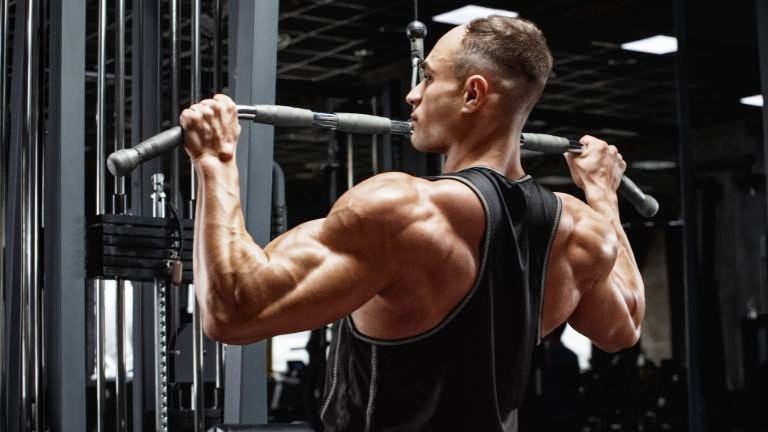
- Top Gym Machines for Back Workouts With Exercises
- 1. Lat Pulldown Machine
- 2. Seated Row Machine
- 3. Chest Supported Machine Row
- 4. Landmine Row
- 5. Pec Deck Machine (Reverse Fly)
- 6. Back Extension Machine
- 7. Smith Machine For Back Workout
- 8. Assisted Pull-Up Machine
- 9. Rowing Machine
- 10. Double Pulley Cable Machine
- Benefits of Using Machines for Training Back Muscles
- 1. Targeted Muscle Engagement
- 2. Safety and Control
- 3. Versatility
- 4. Ease of Use
- 5. Better for Rehabilitation
- 7. Effective for High-Volume Training
- Conclusion
Top Gym Machines for Back Workouts With Exercises
A strong, sculpted back is a key fitness goal for many gym-goers. While free weights like barbells and dumbbells are effective tools, it is important to consider back workout machines when developing your back training regimen.
Machines help keep muscles stable, make moving around easier, and make lifting heavier things safer.
Here are 10 gym machines that you can use for a back workout:
1. Lat Pulldown Machine
The Lat Pull-Down Machine is one of the most popular and versatile gym machines. It is specifically designed to target the muscles in your back, primarily the latissimus dorsi (or “lats”). It can be used for various exercises to build a stronger and wider back.
The exercise is easy to learn and very effective at building back strength. It can be performed with different variations.
With simple adjustments to your grip, posture, or the type of bar you use, you can turn this classic exercise into a multi-faceted tool for back development.
The machine often comes with various handle attachments, offering different grips for more targeted workouts.
- Wide-grip lat pulldown
- Close-grip lat pulldown
- Reverse-grip (supination) lat pulldown
- Neutral-grip lat pulldown
- Straight-arm lat pulldown
- Single-arm lat pulldown… Many More.
Muscles Worked
- Primary Muscles Worked: Latissimus Dorsi
- Secondary Muscles Worked: Rhomboids, trapezius, Levator Scapulae, rear deltoid muscle, Teres Major, Infraspinatus and Teres Minor.
- Stabilizing Muscles Worked: Biceps Brachii, The brachialis, brachioradialis, Serratus Anterior and Core Muscles.
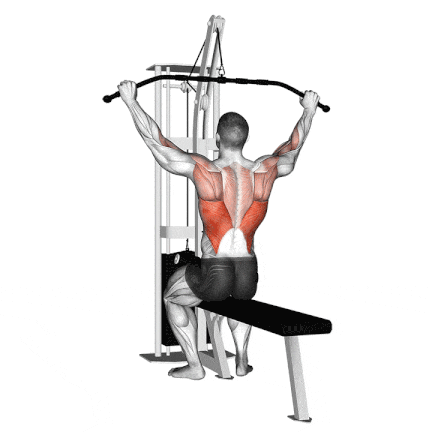
How Does It Work?
Adjust the thigh pads and choose a weight on the lat pulldown machine that works for you. Sit down and place your legs under the pads to secure your knees.
Grip the bar using a wide overhand grip, slightly wider than shoulder width. Arms should be fully extended overhead. Pull the bar downwards towards your upper chest. To perform this action, focus on using your lats, not your biceps.
Release the bar back to the starting position with your arms fully extended and feel the stretch in your lats.
2. Seated Row Machine
The seated cable row is a compound exercise that utilizes a weighted horizontal cable row machine to work the upper body muscles. It is an excellent all-around compound exercise for developing mainly the middle back, while offering useful arm work as well.
The rowing movement targets the back muscles differently than vertical pulling motions like lat pulldowns. It is an excellent exercise for beginners and can be part of an upper-body strength workout.
This exercise can be performed in various ways to target back muscles from different angles.
Different Attachment Used For Cable Row Exercise:
- V-bar attachment
- Wide D Handle Row Bar
- Straight bar
- Rope
- Zigzag Handle
- D Handle
Muscles Targeted
- The main muscles worked: Latissimus dorsi, rear deltoid and Trapezius muscle groups.
- Secondary muscles worked: Rhomboids, Biceps, brachialis, Brachioradialis, Infraspinatus.
- Antagonist Muscles worked: Chest, triceps, front deltoid.
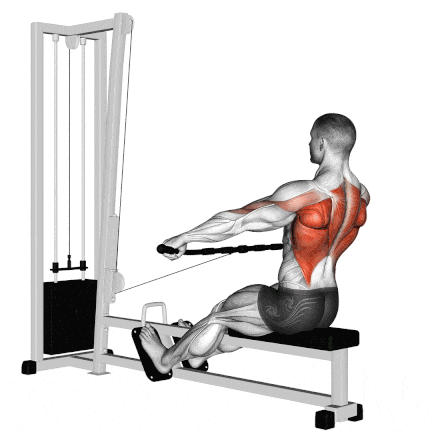
How Does It Work?
The Cable row is a strength training exercise that primarily targets the upper back, shoulders, and arms muscles. It involves pulling a cable towards your body while sitting or standing in front of a cable machine.
Sit on a seated cable pulley rowing machine with legs slightly bent and feet supported against the crossbar. Take hold of the handles with your arms extended and back stretched.
Pull the handles to come as close to the lower chest/abdomen as possible. Slowly return the handle to the starting position.
3. Chest Supported Machine Row
The Chest-Supported Machine Row is specialized gym equipment that isolates your back muscles while supporting your chest and torso.
This machine is an excellent option for those with lower back issues or who want to focus exclusively on their upper back muscles, as it minimizes the strain on the lower back.
The equipment usually consists of a padded chest support, a seat, and handlebars or grips connected to a weight stack or plates. You can typically use an underhand, overhand, neutral, close, or wide grip.
Muscles Worked
- The primary muscles are the latissimus dorsi, traps rhomboids, and posterior deltoids.
- The Biceps and forearm assist in the pulling motion.
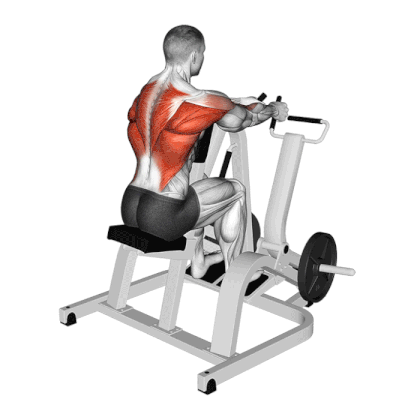
How Does It Work?
Sit down on the machine’s seat, and adjust it if necessary so that your chest is flush against the padded chest support. Reach forward and grip the handles. Ensure that your spine is neutral and your chest is pressed firmly against the pad.
Initiate the rowing motion by pulling the handles towards your torso. Slowly return the handles to the starting position.
4. Landmine Row
If you are looking to add freshness and variety to your gym back workouts and give yourself a new challenge, give this landmine row exercise a try.
The Landmine Row is a unique and versatile strength training exercise that utilizes a barbell anchored into a landmine attachment or securely placed in a corner.
The angled position of the barbell gives you a different strength curve than traditional rows, which adds variety to your back workout and targets your muscles in a new way.
Muscles Worked
- The primary muscles worked by the landmine row are the latissimus dorsi, trapezius, rhomboids, and erector spinae.
- The exercise also targets secondary muscles such as the deltoids, biceps, forearm flexors, and rotator cuff.
- Additionally, the landmine row engages muscles of the core, glutes, abdominal, and oblique.
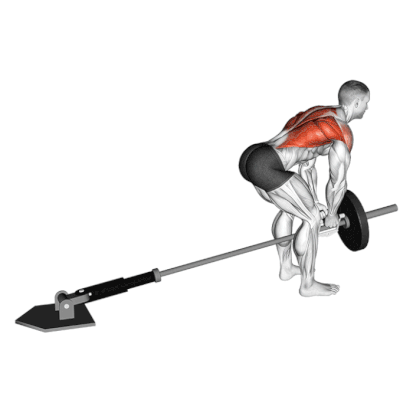
How Does It Work?
Anchor one end of a barbell into a landmine attachment. Stand facing the weighted end of the barbell, with your feet shoulder-width apart. Bend your knees and hips to lower yourself into a semi-squat position.
Grip the end of the barbell and pull the weighted end towards your chest. Slowly lower the barbell back to the starting position.
Know More: Landmine Exercises For Building Muscle And Strength
5. Pec Deck Machine (Reverse Fly)
The Pec Deck machine is traditionally used for chest exercises but can be adapted for a Reverse Fly to target your upper back muscles. It usually consists of a seat, back support, and two arm pads or handles that can be adjusted to various angles.
For the reverse fly, you’ll use the machine in the opposite direction from the conventional pec deck fly. This is a simple yet effective exercise increases deltoid muscle definition and strength.
The pec deck rear delt machine fly targets your upper back muscles and shoulder muscles, particularly the rear deltoids, (backside of your shoulders), Traps and rhomboid.
The Rear delt fly machine provides consistent resistance throughout the entire range of motion. Additionally, this machine offers various technical adjustments, such as grip positions, trajectory, and range of motion settings.
Muscles Worked
- The primary muscles worked by the pec deck machine are the rear deltoids.
- The exercise also targets secondary muscles such as the rhomboids, teres major, infraspinatus, and middle trapezius.
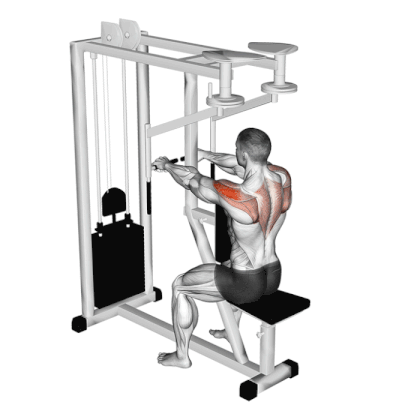
How Does It Work?
The seat height and position of the handles should be adjusted to fit your body. Sit on the machine with your chest against the pad or support. Your feet should be flat on the floor, and your knees should be slightly bent. Grab the handles.
Pull your arms outward and backward in an arc-like motion. Keep pulling until your arms are stretched out to the sides. Slowly release the tension and return your arms to their starting position.
6. Back Extension Machine
The Back Extension Machine is an essential piece of gym equipment specifically designed to target the muscles in your lower back. This machine is often found in both commercial and home gyms. It aims to strengthen your back and improve your posture.
The machine typically features a padded surface for your hips and thighs and foot pads to anchor your feet, enabling you to perform hyperextension movements for your back safely.
Results showed that trunk extensions (HE) activated posterior chain muscles more than leg extensions, regardless of contraction type.
The machine offers a safer alternative to free weights for beginners and those recovering from an injury, since it provides a controlled range of motion. It’s a simple exercise to learn, so you can start using it right away.
Muscles Worked
- The primary muscles worked by the back extension are the erector spinae muscles.
- The exercise also targets secondary muscles such as the glutes and hamstrings.
- Additionally, the back extension engages muscles of the core, abdominal, and oblique.
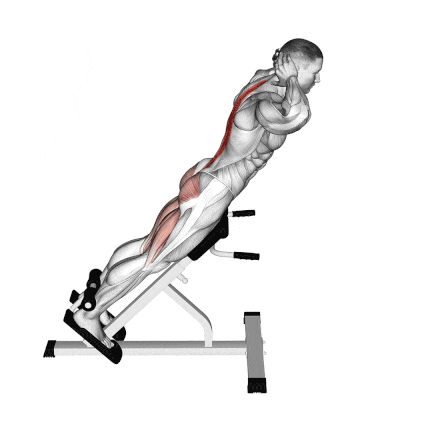
How Does It Work?
Adjust the pad so that it supports your thighs and hips. Bend your knees slightly and secure your feet under the footplates. Cross your arms over your chest or place your hands gently at the side of your head.
Exhale and raise your upper body up until your shoulders, spine, and hips are in line. Engage your core and gently slide your shoulders back—Inhale as you lower yourself back to the starting position.
7. Smith Machine For Back Workout
The Smith Machine is a versatile piece of gym equipment consisting of a barbell fixed within steel rails. It allows for vertical or near-vertical movement and provides an element of safety and control not always present in barbell exercises.
The Smith Machine’s adjustable safety stops make it a great choice for various workouts, from deadlifts and Smith Machine upright rows to bent-over rows. It’s a one-stop shop for both newbies and seasoned athletes. Let’s explore how to use this machine for a robust and varied back workout.
The muscles targeted for back workouts on the Smith Machine can vary based on the exercises chosen. However, here are some of the most commonly targeted back muscles:
- Bent-Over Rows: Target the latissimus dorsi, rhomboids, and middle trapezius.
- Rack Pulls: Focus on the lower traps, latissimus dorsi, and erector spinae.
- Upright Rows: Target the upper traps and rear deltoids.
- One-Arm Smith Machine Rows: This unilateral exercise targets the latissimus dorsi, helping to correct muscle imbalances.
Muscles Worked During Smith Bent Over Row
- The primary muscles worked by the Smith machine bent over a row are the latissimus dorsi.
- The exercise also targets secondary muscles such as the trapezius, scapular stabilizers, biceps, forearms, glutes, hamstrings, and spinal erectors.
- Additionally, the Smith bent-over row engages core muscles, abs, and oblique.
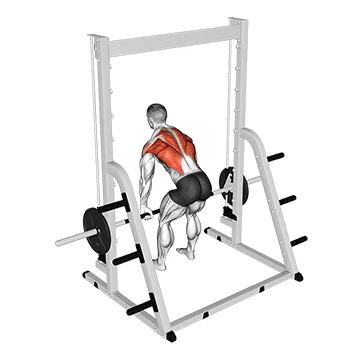
How Does It Work?
Lower the barbell on the Smith Machine to about knee height or slightly higher. Stand facing the bar with feet shoulder-width apart. Bend your knees slightly and hinge at your hips to lean forward.
Reach down and grasp the bar with an overhand grip. Lift the bar slightly and rotate it to disengage from the safety latches. Pull the bar towards your lower ribcage. Lower the bar back down slowly.
8. Assisted Pull-Up Machine
Pull-ups are one of the best bodyweight exercises for building upper body strength, particularly in the back and bicep.
However, they can be challenging for many people, especially those new to fitness or recovering from an injury. This is where the Assisted Pull-Up Machine comes into play.
This specialized gym equipment has a counterweight system that offsets some of your body weight, making it easier to perform pull-ups or chin-ups. The machine typically consists of a pull-up bar attached to a weight stack via a pulley system, along with a platform or knee pad to place your knees or feet on.
Muscles Worked
- Works the lats, biceps, forearms, and rear.
- Hits the middle and upper back, including the rhomboids and lower traps.
- The core is engaged to stabilize the body during the movement.
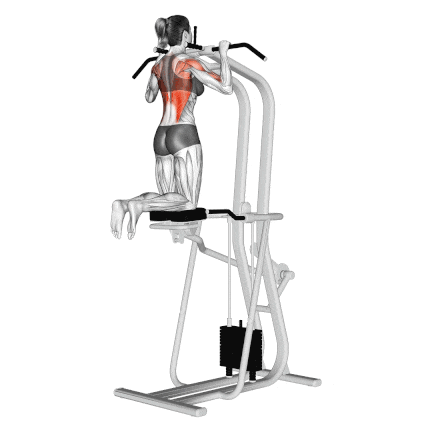
How Does It Work?
Choose an appropriate counterweight on the machine’s weight stack. The higher the weight, the more assistance you’ll receive. Place your knees or feet on the platform or knee pad. Hold the pull-up bar with your chosen grip.
Pull yourself up towards the bar, aiming to raise your chin above it. Slowly and controlled, lower yourself back to the initial position.
9. Rowing Machine
The Rowing Machine, often referred to as a “rower,” is gym equipment designed to simulate the action of rowing a boat. It is an excellent tool for cardiovascular conditioning and provides substantial muscular engagement across various body parts.
The rowing machine, which consists of a sliding seat, footrests, a handle attached to a chain or rope, and a flywheel for resistance, is as versatile as it is effective.
Rowing machines are an all-in-one solution for burning calories, improving cardiovascular health, or gaining strength.
Muscles Worked
The rowing machine engages multiple muscle groups, making it a comprehensive workout option:
- Leg Muscles: Quadriceps, hamstrings, and calves are engaged during the leg push-off phase.
- Back Muscles: As you pull the handle toward you, the latissimus dorsi, rhomboids, and upper traps are worked.
- Core Muscles: Your abs, obliques, and lower back.
- Arm Muscles: Both the biceps and triceps are worked during the pulling and recovery phases.
- Shoulder Muscles: The rear deltoids are engaged when pulling the handle, while the front deltoids are involved during the recovery.
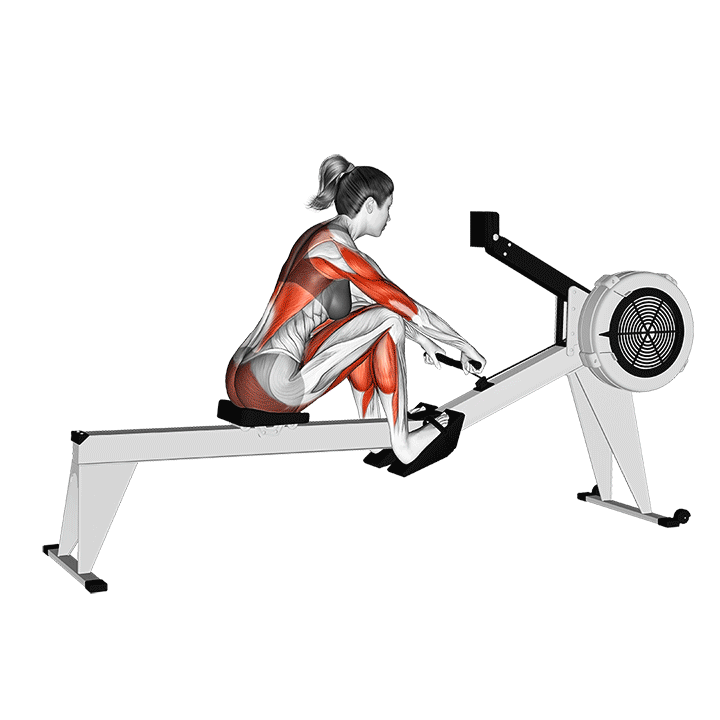
How Does It Work?
Sit down on the sliding seat and secure your feet in the footrests. Grab the handle with both hands and extend your legs. Slide forward on the seat by bending your knees and approaching the flywheel. In a fluid motion, push through your heels to extend your legs and pull the handle toward your lower ribs.
Reverse the motion to return to the initial position, extending your arms before bending your knees to slide back toward the flywheel.
10. Double Pulley Cable Machine
The Double-Pulley Cable Machine is versatile and effective gym equipment that offers a wide range of muscle-targeting and isolation exercises.
Unlike free weights, the cable machine provides constant tension throughout the range of motion.
Featuring two adjustable pulleys, this machine allows you to perform various pulling and lifting movements from various angles, optimizing your back training for strength, hypertrophy, or endurance.
Here are some effective back exercises you can perform on this versatile machine:
- Face Pulls: Great for working the rear deltoids and upper traps, also beneficial for shoulder health.
- Straight-Arm Pulldown: Isolates the lats without involving the biceps. It is a great finishing move for a back workout.
- Single-Arm Cable Row: Allows for greater range of motion and isolates one side of your back at a time.
- Cable Pull-Through: Primarily targets the lower back and glutes but also engages the lats during pulling.
- Cable High Row: Targets upper lats and traps, great for sculpting the upper back.
- Cable Y-Raise: Focuses on the lower traps and helps improve posture and shoulder stability.
- Cable Shrugs: Targets the upper trapezius, great for building bigger shoulders.
- Cable Upright Row: Mimics the motion of a T-bar row, emphasizing the middle and upper back.
- Standing Low Cable Row: This variant targets the lats and lower traps while engaging the core for stabilization.
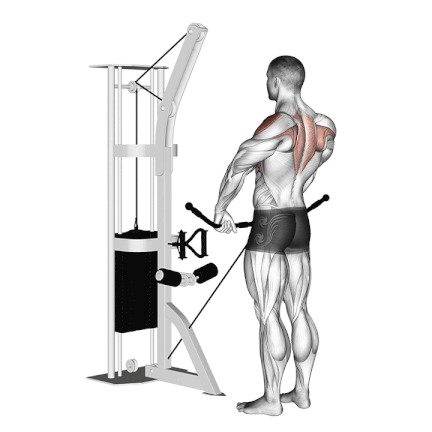
Benefits of Using Machines for Training Back Muscles
When it comes to building a strong, well-defined back, gym machines offer several advantages that can complement free-weight exercises. Whether you’re a seasoned athlete or a fitness novice, here’s why you might want to consider using gym machines for your back workouts:

1. Targeted Muscle Engagement
The debate between free weights and machines will never completely go away, since there are benefits to both.
Free weight exercises are more likely to recruit more muscle activation during a movement, whereas machines are more likely to focus on particular muscle groups. Machines are designed to isolate specific muscle groups.
For instance, the lat pulldown machine targets your latissimus dorsi, while the seated row machine focuses on your middle and upper back. This helps you pinpoint weaknesses and work on them directly.
2. Safety and Control
One of the biggest benefits of using machines is that they reduce the risk of getting hurt. Many machines have adjustable seats, pads, and weight stacks to ensure you can customize your body’s fit.
Gym machines generally offer a safer way to exercise, especially for beginners. The controlled motion path reduces the risk of injury, so you can push yourself with heavier weights without needing a spotter.
A study that looked at gym-related hospital visits found that nearly 90% of patients were there because they had hurt themselves with free weights.
3. Versatility
Machines like the Double Pulley Cable Machine are highly versatile. They allow you to perform various exercises by simply adjusting the pulleys or changing the handle. This enables you to engage your back muscles from different angles, leading to a more well-rounded workout.
4. Ease of Use
Machines are generally easier to use than free weights, particularly for those new to exercising. They come with instructional placards and are easier to set up, making your workout more efficient.
5. Better for Rehabilitation
If you’re recovering from an injury, machines can be an excellent tool for safely regaining strength without placing undue stress on your joints or risking further injury.
7. Effective for High-Volume Training
Because of the safety and ease of use, machines are excellent for high-volume training protocols, often requiring quick transitions between exercises and resistance levels.
Conclusion
Gym machines can be a good way to build a more robust and wider back, improve posture, and reduce the risk of getting. With different grips and variations, you can shift focus between the muscle groups worked.
Some of the most popular gym machines for back workouts include the lat pulldown machine, seated row machine, chest-supported machine row, and double pulley cable machine.
Furthermore, the Smith and rowing machines can also be used for a comprehensive back workout.
So, the next time you’re at the gym, remember these tools. Add them to your workout routine and watch your back development go up.

Manish is a NASM-certified fitness and nutrition coach with over 10 years of experience in weight lifting and fat loss fitness coaching. He specializes in gym-based training and has a lot of knowledge about exercise, lifting technique, biomechanics, and more.
Through “Fit Life Regime,” he generously shares the insights he’s gained over a decade in the field. His goal is to equip others with the knowledge to start their own fitness journey.

I found the above back Extension Machine No. 6 above on your website. There wasn’t any details about purchasing or the price if you have this item for sale.
Also do you have a store in the UK or Ireland or the EU.
I would appreciate if you would let me know the details. My full contact details below.
Regards,
JOHN MAHER S.C.S.I. (Retired).
Dromlohan,
Kilcornan,
Co. Limerick.
V94 0F43
Email: jo*****************@*****ok.ie
Mobile: 085 8500 200